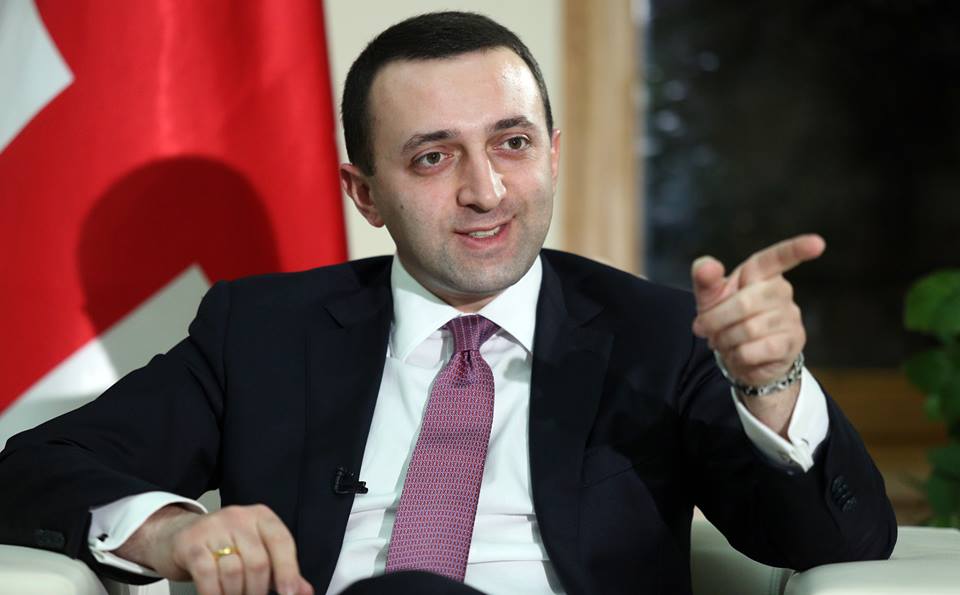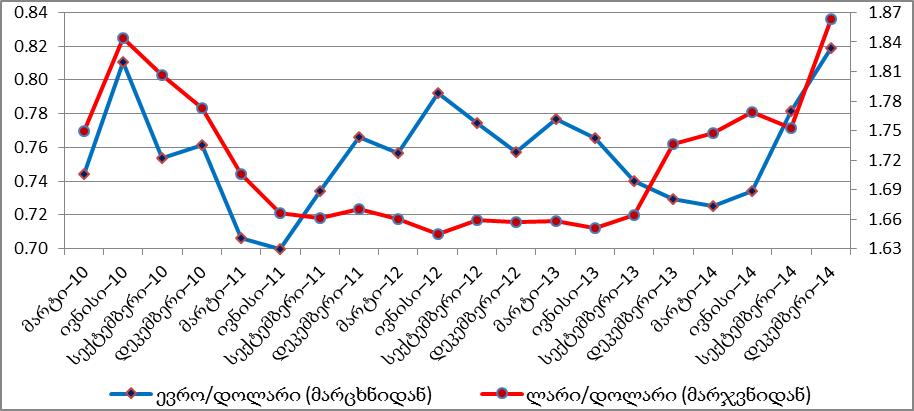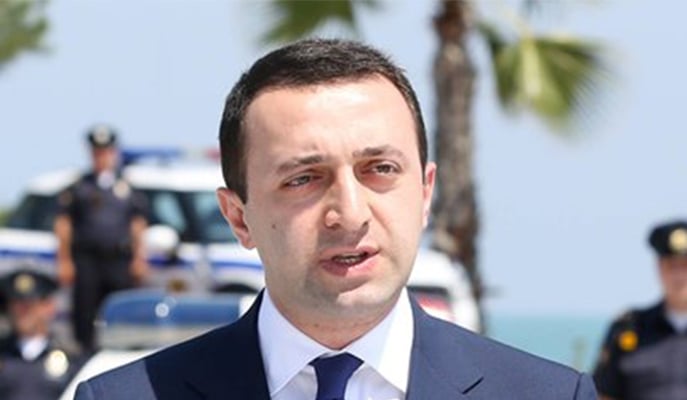On 2 February 2015, as a guest on IMEDI TV, the Prime Minister of Georgia, Irakli Gharibashvili, stated that Georgia’s sluggish economic growth was caused by the economic crises in Russia and Ukraine. However, he added that the government managed to achieve a 4.7%-4.8% economic growth rate in 2014 which will increase to 5% after some corrections. Mr Gharibashvili asserted that it is a huge success to have a 5% economic growth rate in Georgia whereas leading European countries are registering a less than 3% economic growth rate at the same time.
FactCheckverified the accuracy of the statement.
On 30 January 2015, the National Statistics Office of Georgia published preliminary information regarding the country’s economic growth in 2014. According to the information, Georgia’s economy grew by 4.7% in 2014 which is 0.3% less than the 5% forecast by the Government of Georgia.
The table below shows the rate of economic growth in Georgia in the years of 2004-2014 together with a list of selected important events occurring in the same period.
Table 1:
GDP Growth Rate in Georgia in 2004-2014
|
Year |
GDP Growth Rate |
Selected Important Events |
|
2004 |
5.9% |
Revolution in Ajara, aftermath of the 2003 Rose Revolution |
|
2005 |
9.6% |
Terrorist attack in Gori |
|
2006 |
9.4% |
Russian trade ban, special operation in Kodori Gorge |
|
2007 |
12.6% |
Mass protests, resignation of the President |
|
2008 |
2.6% |
Parliamentary elections, Russo-Georgian war, world financial crisis |
|
2009 |
-3.7% |
World financial crisis, mass protests |
|
2010 |
6.2% |
|
|
2011 |
7.2% |
Mass protests (May 26) |
|
2012 |
6.4% |
Parliamentary elections, change of the government |
|
2013 |
3.3% |
Presidential elections |
|
2014 |
4.7% |
Russia-Ukraine war |
The aforementioned list of selected important events clearly illustrates that Georgia has always experienced processes hampering the country’s peaceful development. Despite this, however, the average economic growth was 9.4% in 2004-2007 and 7% in 2004-2012. Therefore, it is not appropriate to ascribe the low economic growth rate of 2013-2014 to the Russia-Ukraine crisis as Georgia registered a 2.6% economic growth even in 2008 when the country withstood a full-scale Russian invasion and the world financial crisis.
Further of note, the hostilities taking place in Ukraine do not occur on the territory of Georgia and, therefore, have less impact upon Georgia’s economy in any case. According to statistics on the country’s trade partners, Ukraine has a 6% share in Georgia’s exports and a 5% share in Georgia’s imports whilst Russia has 10% of the exports and 6% of the imports. Russia’s share in Georgia’s exports was 18% in 2005 which decreased to 8% after the trade ban was imposed in 2006. This all notwithstanding, Georgia’s economic growth rate reached 9.4% in 2006 and 12.6% in 2007 which elevated the country to the 13th place in the world in terms of economic growth rate (Source: World Bank).Remittances from Russia decreased by USD 92 million whilst those from Ukraine decreased by USD 15 million in 2014. However, Georgia’s export to Russia increased by USD 85 million in 2014 as compared to 2013. This means that the Russian factor could not have had a significant negative impact upon Georgia’s economic growth rate.
The 4.7% economic growth rate in 2014 is a preliminary number. The National Statistics Office of Georgia will publish the final data in March 2015. At this moment, it is impossible to say whether or not the final number will exceed the 4.7% margin. Additionally, it must be noted that the Prime Minister’s statement could be perceived as an attempt to influence the National Statistics Office of Georgia.
In his statement, Irakli Gharibashvili compared Georgia’s economic growth rate to the rates of leading European countries. This type of comparison is outright inappropriate. The GDP per capita in developed European countries is far higher as compared to the GDP per capita of Georgia which means that a 1% economic growth in those countries is much higher in absolute numbers than a 1% economic growth in Georgia. The 5% economic growth rate would put Georgia in the 49th place among 152 countries in 2014. Georgia was 96th in 2013 and 39thin 2012. In terms of the economic growth rate, Georgia is outperformed by Turkmenistan (10.1%), Uzbekistan (7.9%), Tajikistan (6.4%), Mongolia (6.3%), Vietnam (5.6%), India (5.5%) and some other countries.
The table below shows the economic growth rate of leading European countries (Germany, France, UK, Italy and Spain) and compares them to Georgia.
Table 2:
Economic Growth Rates of Developed European Countries
|
Year |
Germany |
France |
UK |
Italy |
Spain |
Average Growth |
Georgia |
Difference |
|
2004 |
1.2% |
2.8% |
2.5% |
1.6% |
3.2% |
2.3% |
5.9% |
3.6% |
|
2005 |
0.7% |
1.6% |
2.8% |
0.9% |
3.7% |
1.9% |
9.6% |
7.7% |
|
2006 |
3.7% |
2.4% |
3.0% |
2.0% |
4.2% |
3.1% |
9.4% |
6.3% |
|
2007 |
3.3% |
2.4% |
2.6% |
1.5% |
3.8% |
2.7% |
12.6% |
9.9% |
|
2008 |
1.1% |
0.2% |
-0.3% |
-1.0% |
1.1% |
0.2% |
2.6% |
2.4% |
|
2009 |
-5.6% |
-2.9% |
-4.3% |
-5.5% |
-3.6% |
-4.4% |
-3.7% |
0.7% |
|
2010 |
4.1% |
2.0% |
1.9% |
1.7% |
0.0% |
1.9% |
6.2% |
4.3% |
|
2011 |
3.6% |
2.1% |
1.6% |
0.6% |
-0.6% |
1.5% |
7.2% |
5.7% |
|
2012 |
0.4% |
0.3% |
0.7% |
-2.3% |
-2.1% |
-0.6% |
6.4% |
7.0% |
|
2013 |
0.1% |
0.3% |
1.7% |
-1.9% |
-1.2% |
-0.2% |
3.3% |
3.5% |
|
2014 |
1.4% |
0.4% |
3.2% |
-0.2% |
1.3% |
1.2% |
4.7% |
3.5% |
The average economic growth of leading European countries in 2014 is 1.2%. Further, we can observe that the economic growth rate of these countries has always been below 3% in previous years. The table clearly illustrates that Georgia’s economic growth rate in 2004-2012 was far higher than in 2013-2014.
Georgia managed to achieve a 4.7% economic growth in 2014 owing to the first eight months of the year. The average economic growth for the last four months was 2.3% whilst in November the economy had a negative growth rate of -0.5%.
Graph 1:
Monthly Economic Growth Rate (2014)
Source: National Statistics Office of GeorgiaConclusion
Georgia has been constantly experiencing events hindering the peaceful development of the country, be they revolutions, terrorist attacks, wars, financial crises, mass protests, etc. However and in spite of these factors, its average economic growth rate was 9.4% in 2004-2007 and 7% in 2004-2012. The average economic growth rate in 2013-2014 was 4%. The crisis situations in Ukraine and Russia did not have a significant negative impact upon Georgia’s economy as their shares in Georgia’s trade are not substantial. For instance, exports to Russia decreased by 55% in 2006 but, nevertheless, Georgia registered a 9.6% economic growth rate in 2006 and a 12.7% growth rate in 2007. Therefore, the Prime Minister’s statement that the crises in Ukraine and Russia are behind Georgia’s sluggish economic growth is false.
Additionally, it is inappropriate to compare Georgia’s economic growth rate to rates of leading European countries. The GDP per capita in these countries far exceeds Georgia’s GDP per capita and, consequently, a 1% economic growth in the European countries is much higher in absolute numbers than a 1% economic growth in Georgia. The Prime Minister’s assumption is also wrong when he states that it is an achievement for Georgia if European countries have an economic growth rate lower than Georgia’s 5%. To use the same logic, Georgia had far higher economic growth rates than leading European countries between 2004-2012 but this type of comparison renders wrong conclusions in any case.
FactCheck concludes that Irakli Gharibashvili’s statement is FALSE.





 "Our government managed to achieve a 4.7%-4.8% economic growth rate last year. This is a huge success."
"Our government managed to achieve a 4.7%-4.8% economic growth rate last year. This is a huge success."




